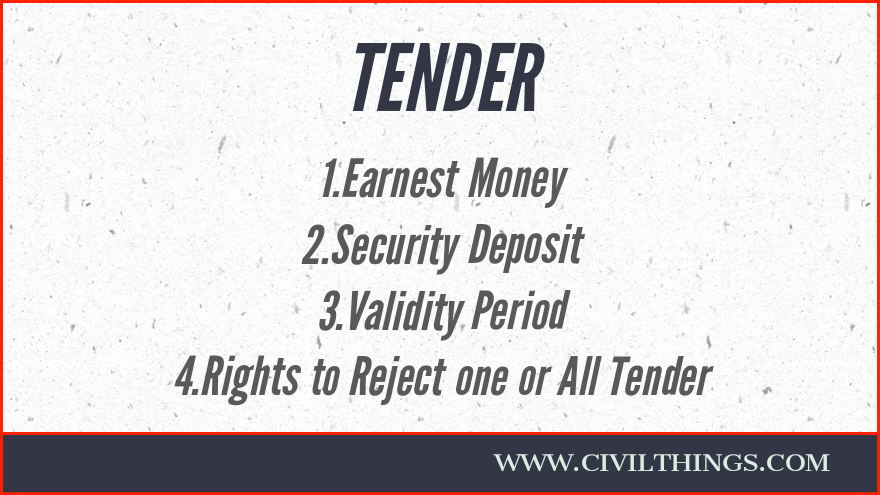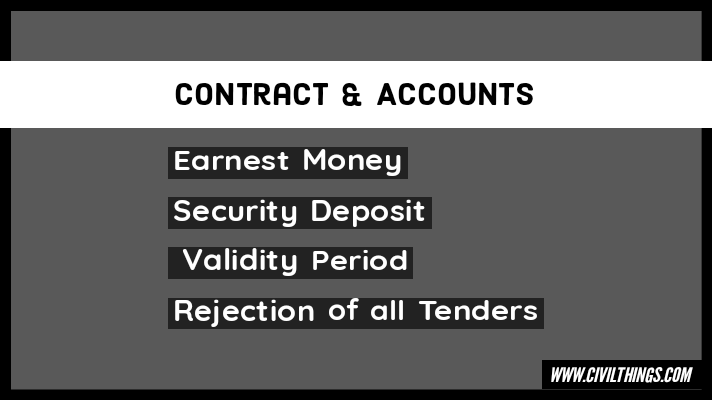The tendering process in civil engineering is like a competition for construction projects. It helps project owners choose the best contractor to do the job. The contractors have to show that they have the right skills and experience, and they have to offer a good price for the project. This process is fair because everyone has a chance to compete. It is also transparent, which means that everything is open and clear. And it helps to make sure that the project gets done well and on time.
Also Read for more Understanding
1. TYPES | TENDER NOTICE | DRAFTING TENDER NOTICE
2. TYPES OF CONTRACT | LABOUR | DEMOLITION | TARGET | NEGOTIATED | MATERIAL SUPPLY
Earnest Money:
While submitting a tender the contractor is to deposit a certain amount, about 1 to 2% of the estimated cost, with the department, as earnest money as a guarantee of the tender. This amount is for a check so that the contractor may not refuse to accept the worker’s run away when his tender is accepted.
The earnest money of the tenderer whose tender has not been accepted is refundable. This amount of earnest money depends upon the estimated cost of work. Ex. Rs. 50.00 for works up to Rs. 2,000.00 etc.
This amount does not carry any interest. Earnest money should be in cash or encashable at any time. In case the contractor refuses to take up the work his earnest money is forfeited.
Security Deposit:
After acceptance of the tender of a particular contractor, he has to deposit a certain amount with the department or owner which is known as Security Deposit. It varies from 5 to 10% of the total estimated cost of the work to be executed.
Usually, the contractor has to deposit this amount before the commencement of the work. If the amount of the security deposit is more in case of large estimate works, the contractor may be asked to remit part of the security deposit to start with, the remaining amount being deducted in installments from h running bills. Usually, earnest money deposited by the” successful contractors is considered as a part of the security deposit and the balance amount collected.
The security deposit shall be refunded to the contractor after three months from the date of payment of the final bill or after the expiry of the guarantee period which is earlier.
Objects of security deposit:
a) Deposit for loans: Serve security against plants, machinery, or material issued by the owner or department.
b) As a punishment: If the contractor is not following the terms and conditions mentioned in a contractor.
Validity Period:
It is a period within which the rates quoted by the contractor are valid. Beyond this period the contractor either may agree or he can refuse to accept the rates for executive the work. This period starts after the tender is submitted. The period depends upon the importance of work, the amount involves, and the time of completion. It ranges from 30 to 90 days.
Rights to Reject One or All Tenders :
Rejecting lowest tender:
The lowest tender is rejected in the following circumstances.
1. When the tender is not submitted in a particular form sold by the department.
2. If the lowest tender is not filled according to the rules and instructions given in the tender form.
3. When any of the pages of the tender is removed.
4. Earnest money is not enclosed along with the tender.
5. Tender is not signed by the contractor or by his representative having power of attorney to sign documents.
6. When contractors put some conditions in front of the department that are not acceptable to the department.
7. When the lowest tenderer does not have adequate finance to execute the work.
8. Lowest tenderer does not have sufficient experience in the type of work tendered.
9. Unsatisfactory reputation of the lowest tenderer.
10. Having inadequate technical staff and equipment.
Rejection of all Tenders :
All tenders are rejected in the following circumstances:
1. When a minimum number of tenders to ensure adequate competition is not received.
2. After the publication of tender notice in newspapers, it is found that changes in designs are very essential.
3. When any fraud is detected.
4. The lowest tenderer has quoted very high rates than the estimated rate.
5. There is no competition for the work and a minimum number of tenders are not received.
6. There are collisions among the contractors.
7. Sickness, financial reverses, or unforeseen happenings has occurred with the owner which enables the owner to proceed with the work.
Corrigendum to Tender Notice and its Necessity:
The last date for accepting complete tender forms can b extended under the following conditions:
1. When the period to prepare a tender for a contractor is short.
2. When there is any major change either in design drawing, specification, or in amount.
3. Tender papers are not ready in the office.
4. Sufficient number of blank tender forms are not sold. The extended last date and time of issuing and accepting the tenders must be brought to the notice of all the contractors by advertising the same in the form of a corrigendum to the tender notice.
Corrigendum to Tender Notice:
In continuation of a tender notice published in this newspaper dated…….. it is hereby notified that the dates of issues and receipt of tenders for the work of……… have been extended upto……. and…….. respectively.
All other conditions remain the same.
Date:……
Sd/-
Executive EngineerEarnest Money:
FAQ:
Q. Define the terms Earnest money
Q. Explain ‘Earnest-Money-deposit’ and ‘Security-deposit.
Q Define Security deposit Explain.
Q Eamest-Money-deposit and Security-deposit.
Q. Explain any four reasons responsible for the rejection of the tender.
Q. Under which circumstances lowest-tenders are rejected by the department?
Q. State four reasons for which a tender is rejected.
Q. Write eight conditions when the lowest tender is rejected.
Q. Define the terms Earnest money
Q. Explain ‘Earnest-Money-deposit’ and ‘Security-deposit.
Q. Explain any four reasons responsible for the rejection of the tender.
Q. Under which circumstances lowest-tenders are rejected by the department?
Q. State four reasons for which a tender is rejected.
Q. Write eight conditions when the lowest tender is rejected.
Hi! I’m Sandip, a civil engineer who loves sharing about Civil Engineering & new ideas and tips. My blog helps you learn about engineering in a fun and easy way!



